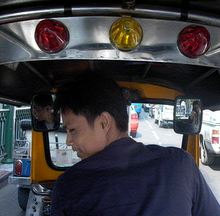The popularity of shopping malls as hang out places may very well be a global phenomenon. Yet, in the case of Jakarta, the utilization of shopping malls as “public” places has been intensified by the growth of commercial areas, diminishing green areas, and privatization of public places.
Panangian Simanungkalit indicated that in 2005 alone, commercial areas (shopping malls, supermarkets, and trade centers) in Jakarta reached the total of 5,100,424 square meters (Kompas, 21 April 2006: 46). Meanwhile, Nirwana Joga pointed out that Jakarta’s green area has been reduced from 37.2% of total area in year 1965-1985, to 25.8% in year 1985-2005, to 13.94% in year 2010 (Joga, 2002). Currently Jakarta’s green area is merely 9.67 percent of total area according to Yayat Supriatna (2004).
Some of green areas have been converted into malls (Plaza Senayan, Mal Taman Anggrek, and Mega Mal Pluit), five-star hotel (Hotel Mulia), upper-middle housing complex (Pantai Indah Kapuk), and even government’s office (Kantor Walikota Jakarta Selatan; Joga, 2002). Even the National Monument (Monas) is no longer accessible for all citizens. The renovation of Monas surrounded it with four meter gate, making the public space inaccessible to underclass citizens – hawkers, panhandlers, and prostitutes.
Interviews conducted with 154 random visitors to five malls in Central and South Jakarta reveal that they visit the malls between two to four times a week for eating (71.43%), watching films (50%), strolling (25.32%), working out (24.68%), conducting work-related meeting (24.03%), shopping (20.78%), and people watching (7.79%). This result indicates that, firstly, shopping is actually not the main intention for most mall-goers; and as such, secondly, these activities do not have to be conducted in shopping malls. So why do people go to the malls?
My argument is because they have no better choices. Malls and other commercial areas are more profit-generating and easier to maintain for developers than culturally-oriented and socially-mixed public places. Yet, these commercial areas are targeted towards specific customers: they segregate people according to social-economical backgrounds. 57.11% of interviewees in my samples are professionals, 32.47% students, and 9.09% house wives. Only 1.23% is in the service sector, and no respondents are member of the working class or in agriculture. The malls where interviews were conducted are not targeted for these “other” classes.
In the case of Jakarta, and of Indonesia to a larger extent, the impact of homogenous and exclusive commercial areas is especially alarming. Many areas in Indonesia have, historically and repeatedly, experienced social unrest caused by clashes between different ethnic, religious, political, and social-economical groups. Casual interactions between different groups of people, including those from different social-economical classes, are often mediated by open public spaces, safe public transportation, and streets with good pedestrian sidewalks. Unfortunately none of these public amenities are available in Jakarta. Jakarta, therefore, desperately needs to re-create its public places, where people from different backgrounds – or at least those who want to – have the options to mingle.
A specific tenant within the malls, cheaper price, and traffic condition to and surrounding the area are other particular reasons the interviewees go to malls. The specific tenants are not just department stores or supermarkets, but also cinemas (50%), fitness centers (24.68%), and bookstores (14.94%). Some 13.64% mention certain ambience of the malls, and 7.14% actually conduct job-related activities in addition to 24.03% of meeting with clients. These very specific reasons indicate that some people have the desire to be culturally entertained and others to be healthy. They appreciate the design and cultural atmosphere being offered by a specific mall. Some even go to the malls to gain knowledge.
Of five malls in my samples, the one that attracts most visitors is located in prime location, easily accessible both by using public and private transportations, and has variety of tenants which cater to different ages. A successful future public places in Jakarta will have to equal, if not exceed, these criteria while avoiding homogeneity. Yet, this may remain a utopian hope for Jakarta, if one particular stand has not changed.
Privatization of public places indicate that Jakarta’s local, regional, and national government need to, first and foremost, have the political will to put forward issues related to public needs – rather than submitting to short-term financial gain, but losing the long-term battle to realize a functional, healthy, society. If this is not a possible expectation, then citizens of Jakarta will have to wait and hope that there will be private enterprises that develop commercial sites that also put forward public concern.
This article is part of paper submitted for “Arte-Polis: Creative Culture and the Making of Place”, an international seminar organized by Institut Teknologi Bandung.
Subscribe to:
Post Comments (Atom)




No comments:
Post a Comment